Too much information
My chemical and microbial romance
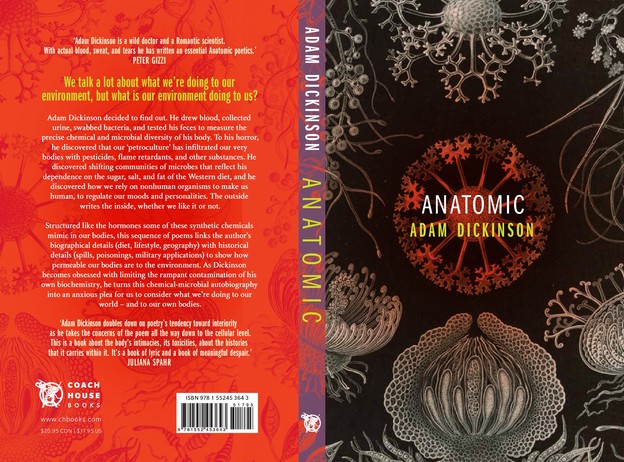
Anatomic is an attempt to think of writing in a more expanded way by incorporating the results of chemical and microbial testing on my body into poems that examine, through personal, biological, industrial, and cultural contexts, how the “outside” writes the “inside” in necessary and toxic ways. I offer my experiences working on this book as one perspective on some of the aesthetic, procedural, and formal concerns associated with this series of commentaries on metabolic poetics.
I got the idea to test myself for chemicals and microbes shortly after I had completed a book of poetry about plastics. While researching The Polymers, I became acquainted with endocrine disrupting chemicals (hormone mimics) and their relationship to plastic materials, cosmetics, and other common consumer products. The aim of The Polymers was to look at plastics as biological and cultural phenomena, to reimagine the structure of polymers (their repetitive chain-like dynamics) in terms of their cultural and linguistic analogues. As part of my compositional process for that book, I worked with scientists to develop some imaginary polymers (with real properties) that might plausibly lie at the heart of some culturally influential texts (you can see some of these on Gary Barwin’s commentary post). My goal with Anatomic was to see if I could read the writing of chemicals in my own body. What else was inside me? I started to think about sequencing my microbiome as part of making a larger inventory.
What happens when we approach the human endocrine system, with its constant exchange of hormonal messages, as a poetics? How might hormones offer examples for poetic form? I took seriously the proposition that chemicals and microbes constitute forms of metabolic writing in terms of their potent effects on bodily biochemistry. Phthalates, for example, which are additives to soft plastics and cosmetics, mimic estrogen in the body and have been associated with various illnesses as well as developmental and behavioral problems (there are disorders of the male reproductive tract now attributed to “phthalate syndrome”). Similarly, microbes can exert important regulatory influences on the immune system and on human mental health. For example, the vast majority of the body’s supply of serotonin — an important neurotransmitter responsible for influencing moods — is manufactured by gut bacteria.
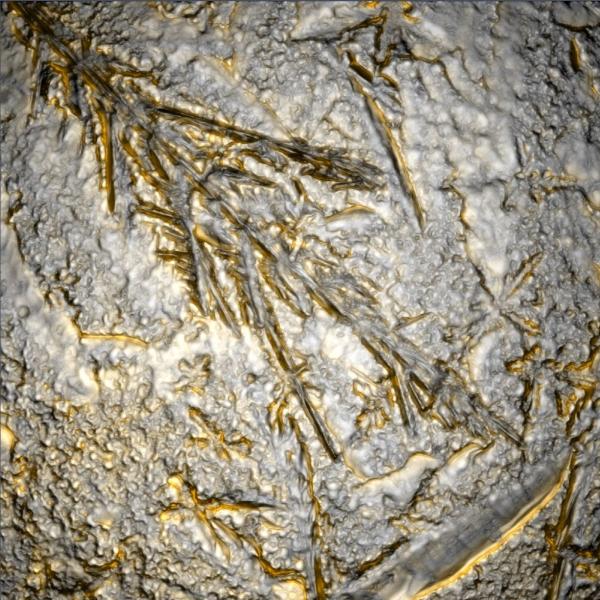
My urine.
How, then, to write this writing? I thought very hard about structural questions, about what form a hormone might take in language. Ultimately, I settled on the sentence and its brief, concentrated manifestation of a dramatic arc (a cause and an effect) as the principal compositional method I wanted to employ. It seems to me that this is analogous to the small anatomical narratives that hormones initiate in the body — they respond to stimuli and produce effects. Hormones are sequential sentences in cascading anatomical stories. Consequently, the prose poem became the dominant form in the book as a way of generating this endocrine analogue. I also liked how the prose poem, as a low-key, ostensibly innocuous, or “formless” form, suggests the subtle ways in which many of the chemicals I tested myself for affect the body: endocrine disruptors, or hormone mimics, intervene in metabolic processes precisely because of their inconspicuousness, their capacity to be mistaken for naturally present hormones. To contrast with the prose poems, I also employed very short lines in a number of sections to underscore a sense of the more atomized drip of these chemically and microbially inflected substances into the biological and cultural metabolism of a body.
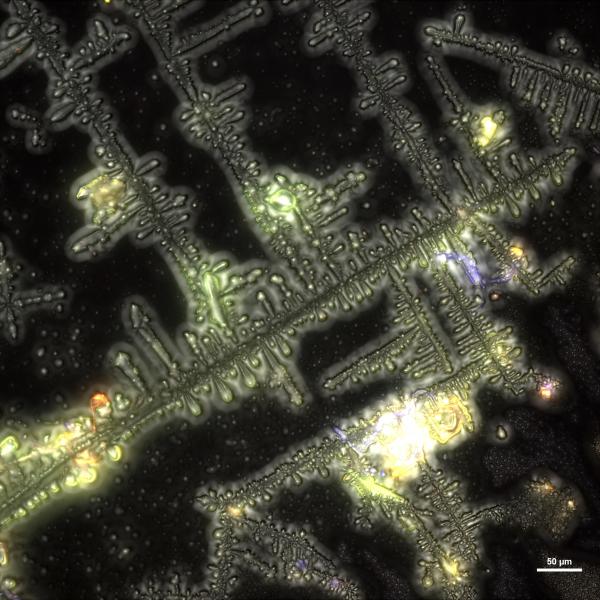
My sweat.
One of the consequences of the “slow violence”[1] of chemical pollution is that human bodies have become crowded with a volatile mix of petrochemicals and their derivatives. PCBs and DDT are common examples of such bioaccumulating, lipophilic toxins. The hormone is often the site of earliest sensitivity to this violence, inflicted by way of misreading and disrupted sequence. What does it look like to write through these matters and questions with the hormone as a guide? How might poetry itself function as a productive hormone disrupter within larger cultural narrative sequences? Anatomic is structured like a hormone inasmuch as there is a long poem in sections (called “Hormone”) that runs through the book with the chemical and microbial poems floating in this stream. The “Hormone” poem is, among other things, a meditation on crowds and crowd theory (as I came to discover my body crowded with chemicals and microbes). It borrows from and makes reference to texts about crowds and crowd theory, including Gustave Le Bon, Elias Canetti,[2] Jodie Dean, and others. The chemical and microbial poems each possess an epigraph that indicates the level of a particular chemical in my blood or urine, or the presence of a microbe on or in my body. (See a section of “Hormone” in the Boston Review)
I tested my blood and urine for the following chemicals:
⌬ Phthalates,
⌬ PCBs (polychlorinated biphenyls),
⌬ PFCs (perfluorinated chemicals),
⌬ OCPs (organochlorine pesticides),
⌬ OPIMs (organophosphate insecticide metabolites),
⌬ PAHs (polycyclic aromatic hydrocarbons),
⌬ HBCDs/PBDEs (flame retardants),
⌬ Triclosan (antibacterial additive),
⌬ Parabens,
⌬ BPA (bisphenol A),
⌬ and 31 heavy metals.
I employed the biomonitoring protocols used by the Centers for Disease Control and Prevention (USA), Health Canada, and Environmental Defence (Canada) in order to test for chemicals widely present in the environment and believed to exist in most humans to varying degrees (what is in me is in you, too). Moreover, in addition to testing various areas of my body for bacteria (hand, genitals, ear, nose, and mouth), I sequenced my microbiome with the help of researchers at several universities, obtaining a deep metagenome and virome characterization of a stool sample, plus additional marker gene sequencing (16S rRNA, 18S rRNA and ITS) to determine not just the bacteria but also the viruses, microbial eukaryotes (like giardia), and fungi in my stomach. By focusing on the “outside” that is “inside,” my hope with this work is to draw attention to the coextensive and intra-active[3] nature of the body with its environment and the consequent implications for linking the human to the nonhuman and the personal to the global in environmental ethics. While I am acutely aware of the way my body is necessarily marked by certain demographic privileges, I am also interested in the strange democratizing power of this form of pollution and biological colonization. The chemical and microbial signatures may be different for distinct communities of people, but the chemicals and microbes are in us all.
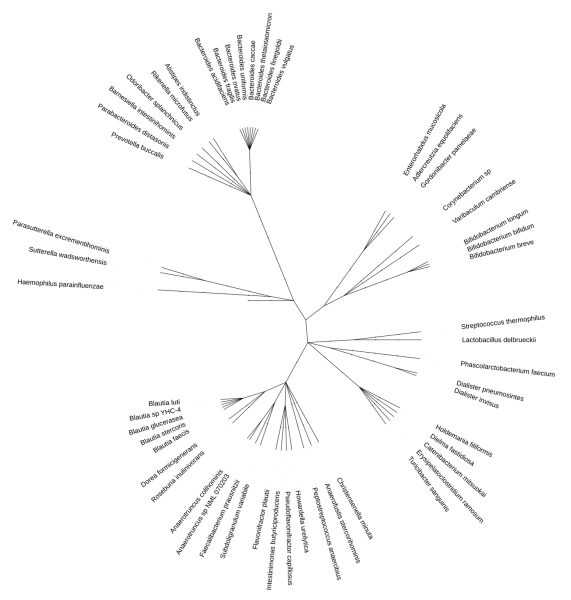 An unrooted phylogenetic tree depicting relationships between baterial species in my gut. [Click to enlarge]
An unrooted phylogenetic tree depicting relationships between baterial species in my gut. [Click to enlarge]
The book begins with a list of all the chemicals I was tested for and all the microbes (at the family level) I found in and on my body. I deliberately wanted my research methods and data to be formally and conceptually present in the book. There are graphs and charts displaying chemical concentrations in my blood and urine, along with a diagram of my most common metabolic pathways, and an unrooted phylogenetic tree depicting the relationship between bacterial species found in my gut. There are microscope images of my blood, urine, sweat, and hair (the excretory pathways some of these chemicals take from my body) as well as photographs of the experimental processes I undertook.
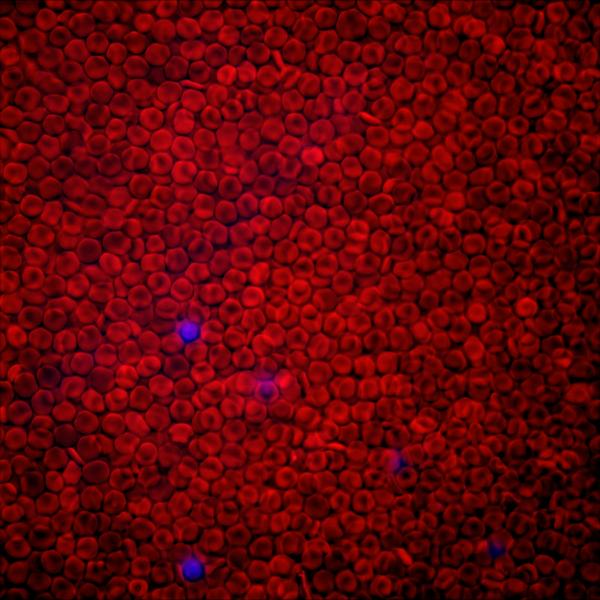 My blood cells (red and white).
My blood cells (red and white).
I also decided to include a series of “specimen reports” that reflect on some of my experiences performing the tests and acquiring the results. It turned out to be much more complicated than I anticipated. It wasn’t possible to simply work through a doctor because I had no obvious symptoms that required any specific diagnostic procedure. Eventually, I managed to get some information from an environmental activist organization in Toronto (Environmental Defence) about testing protocols they had used for an initiative involving some provincial politicians. This led me to laboratories in British Columbia and Québec. Through the generous assistance of some colleagues at my university, I drew the required amount of blood and spun it in a centrifuge to separate the serum. The centrifuge we used was small and as a result required tiny four-milliliter tubes. By the time we were finished I had filled over seventy of them and my arms were bruised and sore. I have never enjoyed having my blood drawn; at first I looked away as the process was unfolding. By the end of it, however, I was yanking on the tourniquet with my teeth. I was doing all of this in a laboratory with the kind assistance of a Health Sciences graduate student who was not a trained phlebotomist. When the university later found out what I had done, new rules were put in place.
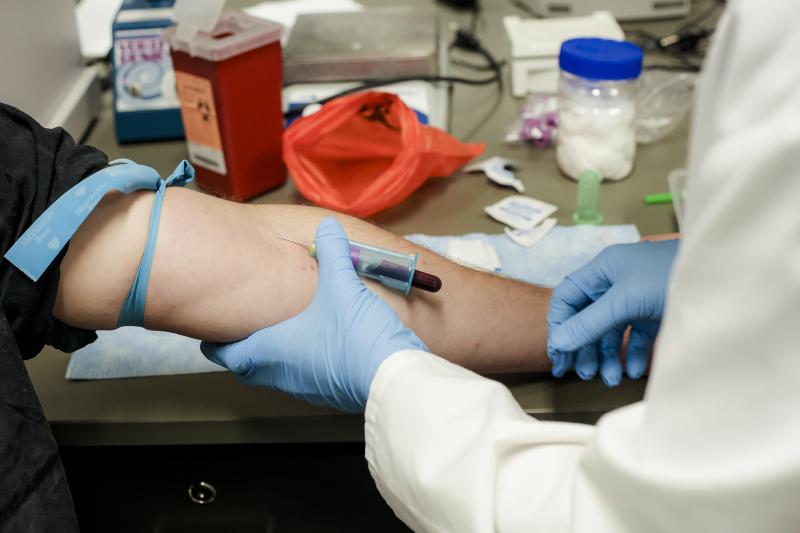
Drawing blood.
The microbiome testing was also an adventure. I went to the ecopoetics conference at Berkeley in 2013 and eventually, through references there, made connections with some microbiologists willing to help me. I later worked with the American Gut Project and uBiome to conduct further testing. As a Canadian, there were some challenges associated with shipping my stool sample (a biohazard) across the border. At one point, as I describe in Anatomic, it looked as though I was going to have to go to Buffalo and spend a couple of days in a hotel room collecting my poop in order to mail away the necessary amount from inside the USA. This was complicated by the fact that I needed a hotel room with a deep freezer to keep everything at the right temperature. Eventually, through the kind assistance of scientists at the University of Colorado, I received the appropriate paperwork and I could ship everything from my own basement freezer.
One of my main approaches to data translation in this book was to find different ways to tell the stories of a body composed of other organisms and volatile chemicals with their own tales to tell about life in the Anthropocene. Consequently, I produced poems that explore potential health effects, curious aspects of microbial behavior (some bacteria are both beneficial and harmful depending on circumstances), and larger social issues such as the culture of masculinity and the anxieties produced by the estrogenic effects of endocrine disruptors. I also wrote about the way in which the presence of mercury in my blood made me think about my connection as a privileged settler to the racial injustices associated with mercury contamination in an Indigenous community in my home province. I found shifted microbial communities associated with the Western diet, such as those related to high sugar consumption. This made me think about the history of sugar, its connection to colonialism, slavery, and capitalism (see “Mouthfeel”). My body contained and continues to contain the traces of all these global forces.
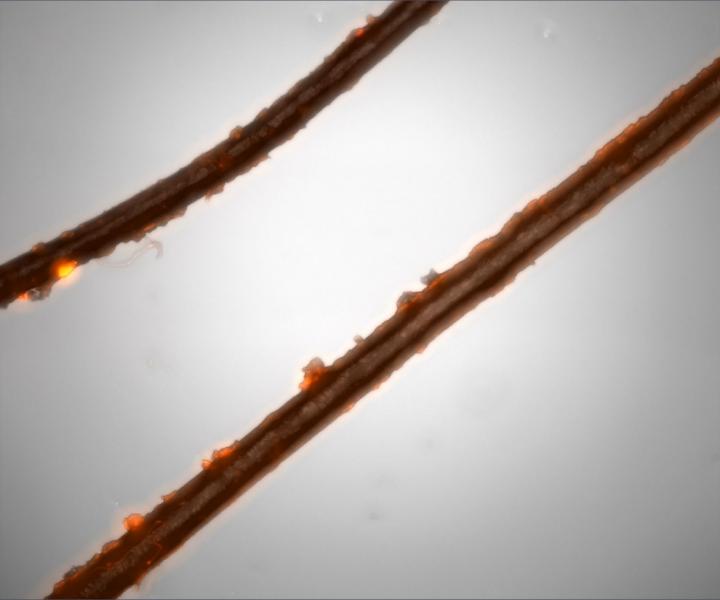
My hair.
The tension between the individual and the larger crowd is one of the primary tensions of this book. Both hormones as well as microbes behave according to a kind of quorum sensing. In her book Crowd and Party, Jodi Dean focuses on the current neoliberal “era of communicative capitalism” and its “commanded individuality.”[4] For her, the crowd is the fundamental unit of politics rather than the individual.[5] Are there ways, however, in which our chemically and microbially crowded bodies might be seen as an opportunity to write about and against the prevailing political pressures that have generated such metabolic interventions? Is it possible to use the emphasis on the neoliberal individual against itself when it comes to generating concern about the invasive consequences of how accumulating capital and chemicals have rewritten human metabolism? I can see Monsanto written into my blood as I read the results of my PCB tests. What gives a company the right to effectively edit our bodies without our consent? What happens when this writing is made legible? My interest in thinking crowds through hormonal cascades has emerged from an interest in these questions.
I’ve also been working with disruption or interruption in the context of crowds and bacteria colonies. I’ve cultured bacteria that I swabbed from my body on some texts in order to generate this disruptive, crowded writing. This piece below from Anatomic involves a quotation from Cortes’s second letter to Charles V upon meeting Moctezuma in Mexico on November 8, 1519. It is colonized with bacteria that I swabbed from money and from my hands after touching money. The crowd of microbes, the result of the interaction between bodies and systems of exploitation and exchange, have been invited to participate in the creation of an erasure text.
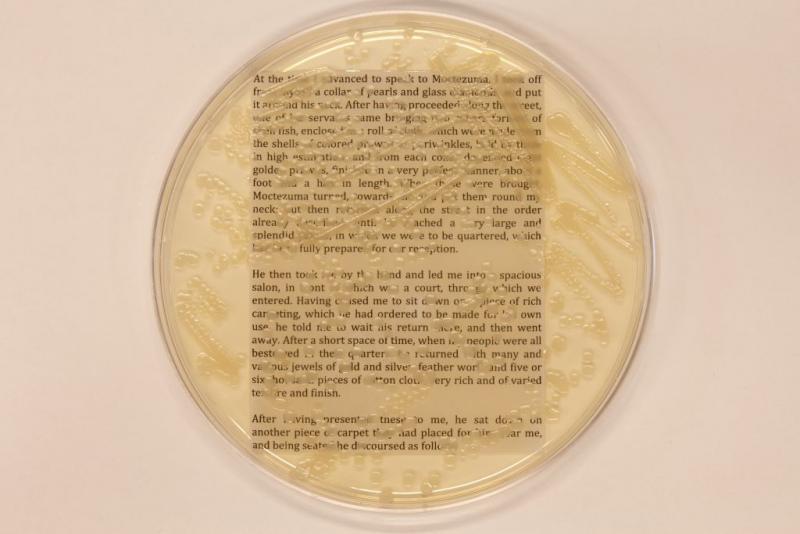
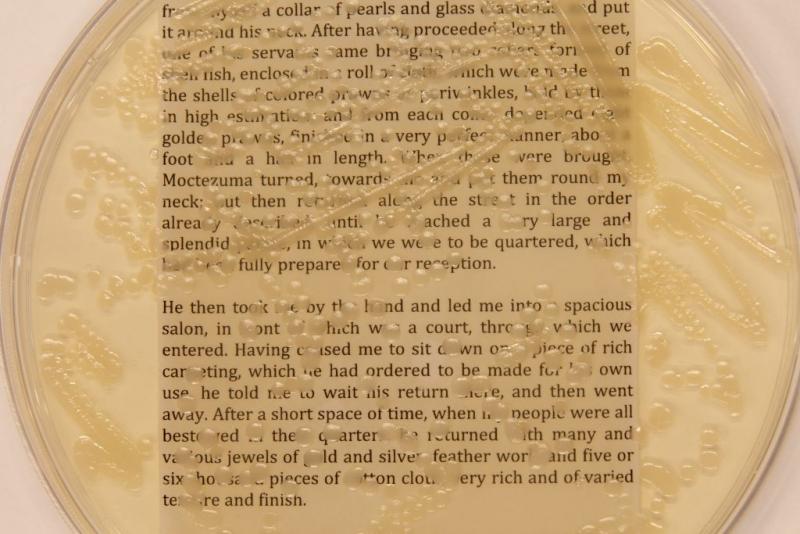 Cortes, Moctezuma, money, and microbes.
Cortes, Moctezuma, money, and microbes.
As the biologist Scott F. Gilbert points out, “‘birth’ is not the birth of a so-called individual. Birth is the continuation of the holobiont community,”[6] the “holobiont” being the organism plus its persistent community of symbiont microbes. This poem concerns a microbe I acquired very early in my life.

My chemicals.
Writing Anatomic has changed my life. I looked into my blood, urine, and shit and saw the residues of agricultural, industrial, and military history. Perhaps naively, I thought I could treat myself like a specimen. While I did experience wonder at the complex agency of these substances and organisms in my body, I wasn’t prepared for the mental health effects of discovering flame retardants, heavy metals, internationally banned chemicals, and microbes associated with inflammation and illness. The intense self-scrutiny caused me to experience serious anxiety and obsessive behaviors. I had to keep a food diary for long periods of time (the microbiologists who were helping me wanted to know what I was eating). I lost a lot of weight. I stressed over the results of my testing. I ended up having a series of health scares prompted by my anxiety and escalating hypochondria, which led to necessary diagnostic tests (I had a colonoscopy at one point, after which I suffered a frightening complication that landed me in the hospital). I wrote about what I found in my body, but I also ended up writing about how it felt to find these things. I didn’t expect the book to be so personal, but in the end the way in which the global metabolism of energy and capital writes the local metabolism of a body is a highly personalized experience. We all have widely varying sensitivities. As I discovered, there are no “safe levels” of any of the chemicals I found. Industries often push for such levels so that they can pollute people with impunity up to a line.
What does it mean to rethink ecological identity in the Anthropocene as a function of potent intra-actions[7] between environmental toxins and symbiotic organisms? What is the ethical potential of understanding identity as a porous, membranous, transcorporeal[8] organization where the metabolic forces within are affected by the global metabolic forces of energy and capital without? In Anatomic I tried to see my own body, the chemicals in my blood and urine as well as the Western diet–influenced microbes in my stomach, as forms of media expressing the biology of petroculture, expressing my own strange intimacy with the energy sources of my historical moment. Being able to read the stories of the chemicals and microbes in our bodily fluids means being able to read the writing of the Anthropocene in ways we haven’t been able to do yet, in ways that might illuminate the common crowds we bear and the crowds in common that we are.
1. Rob Nixon, Slow Violence and the Environmentalism of the Poor (Cambridge, MA, and London: Harvard University Press, 2011).
2. Gustave Le Bon, The Crowd: A Study of the Popular Mind (Kitchener, ON: Batoche Books, [1896] 2001); Elias Canetti, Crowds and Power, trans. Carol Stewart (New York: Farrar, Straus, and Giroux, 1960).
3. Karen Barad, Meeting the Universe Halfway (Durham, NC and London: Duke University Press, 2007).
4. Jodi Dean, Crowds and Party (London and New York: Verso, 2016), 31.
6. Scott F. Gilbert, “Holobiont by Birth: Multilineage Individuals as the Concretion of Cooperative Processes,” in Art of Living on a Damaged Planet: Monsters, ed. Anna Tsing et al. (Minneapolis: University of Minnesota Press, 2017), M81.
8. Stacy Alaimo, Bodily Natures: Science, Environment, and the Material Self (Bloomington, IN: Indiana University Press, 2010).
All of the images above are from Anatomic (Coach House Books, 2018). The image of my blood being drawn was taken by Jimmy Limit. The phylogenetic tree was produced with the assistance of Dr. Alison Waller. All microscope images were produced with the assistance of Lucas Maddalena and Dr. Jeff Stuart.
Metabolic Poetics